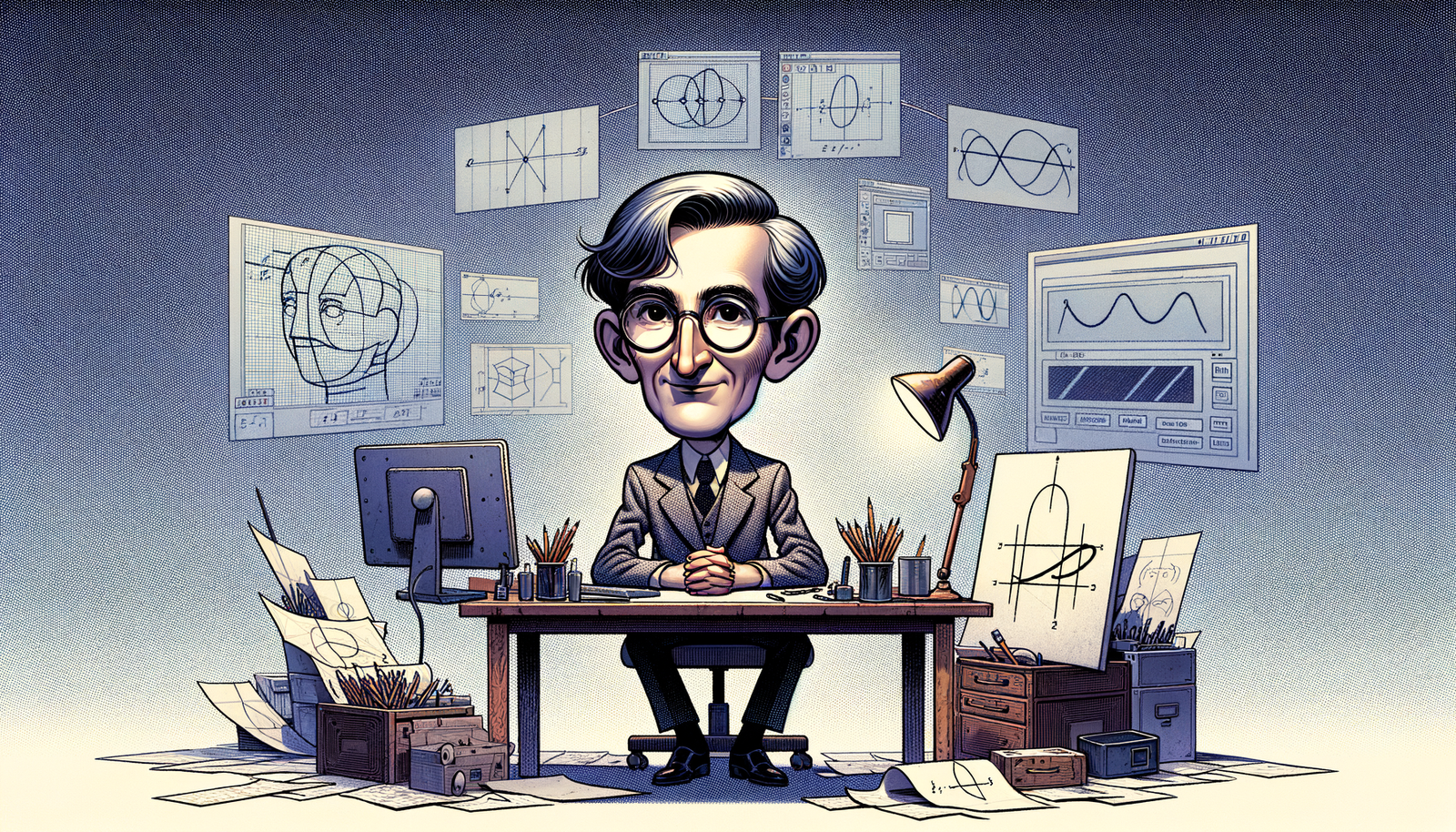Your Cart is Empty
Customer Testimonials
-
"Great customer service. The folks at Novedge were super helpful in navigating a somewhat complicated order including software upgrades and serial numbers in various stages of inactivity. They were friendly and helpful throughout the process.."
Ruben Ruckmark
"Quick & very helpful. We have been using Novedge for years and are very happy with their quick service when we need to make a purchase and excellent support resolving any issues."
Will Woodson
"Scott is the best. He reminds me about subscriptions dates, guides me in the correct direction for updates. He always responds promptly to me. He is literally the reason I continue to work with Novedge and will do so in the future."
Edward Mchugh
"Calvin Lok is “the man”. After my purchase of Sketchup 2021, he called me and provided step-by-step instructions to ease me through difficulties I was having with the setup of my new software."
Mike Borzage
Design Software History: The Pioneering Influence of Paul de Casteljau and the Bézier Curve in Design Software Evolution
November 14, 2024 8 min read


Introduction to Paul de Casteljau and the Bézier Curve
Paul de Casteljau, born in 1930, is a renowned French engineer and mathematician whose work profoundly influenced the field of computer graphics and digital design. During his tenure at Citroën in the 1950s and 1960s, de Casteljau pioneered mathematical algorithms that would become fundamental to computer-aided design (CAD) and modeling. His development of the de Casteljau algorithm provided an efficient and numerically stable method for evaluating polynomials, particularly useful for generating curves and surfaces. Despite the significance of his work, de Casteljau's contributions remained largely unrecognized in the public domain for many years due to Citroën's policy of keeping proprietary research confidential. This secrecy delayed the widespread dissemination of his findings, which only surfaced in the broader community after similar work by Pierre Bézier became public. The Bézier curve, named after Pierre Bézier who was working independently at Renault, is intrinsically linked to de Casteljau's earlier research. Bézier's contributions, published and disseminated more widely, popularized the use of these parametric curves in design and engineering. The importance of Bézier curves in design software and digital modeling cannot be overstated. They offer a mathematical means to create and manipulate smooth, scalable curves essential in various domains, from automotive design to typography and computer graphics. These curves revolutionized the way designers approached modeling by providing tools that combined mathematical precision with intuitive control. The connection between these mathematical concepts and practical design applications represents a significant advancement in bridging theoretical mathematics with engineering solutions. Prior to the adoption of such mathematical models, designers often relied on manual drafting techniques that were time-consuming and less precise. The integration of Bézier curves into computer graphics allowed for the accurate and efficient creation of complex shapes and surfaces. This development not only enhanced the capabilities of design software but also opened new avenues for innovation across multiple industries. Paul de Casteljau's foundational work thus serves as a critical link in the evolution of design technology, illustrating how mathematical innovation can drive substantial progress in practical applications.
Mathematics Behind the Bézier Curve
The Bézier curve is fundamentally a mathematical construct rooted in the field of numerical analysis and polynomial interpolation. Its formulation is based on Bernstein polynomials, which provide a robust and stable foundation for curve representation. The curve is defined parametrically and utilizes a set of control points to determine its shape. The mathematical elegance of the Bézier curve lies in its ability to offer intuitive control over complex shapes through these control points while maintaining computational efficiency. Control points are pivotal in shaping the curve's trajectory. Unlike other interpolation methods where the curve must pass through each point, Bézier curves use control points to influence the direction and curvature indirectly. The initial and final control points are the endpoints of the curve, while the intermediate control points determine the tangents and the overall shape. This approach allows designers to manipulate the curve by adjusting the position of these points, providing an interactive and flexible design process. There are specific types of Bézier curves categorized by their degree, each offering different levels of complexity and control:
- Linear Bézier Curve: Defined by two control points, it creates a straight line between them. This is the simplest form and is used when only a direct path between two points is needed.
- Quadratic Bézier Curve: Utilizes three control points, allowing for a single curve segment that can bend. The additional point provides control over the curvature, making it suitable for simple curved shapes.
- Cubic Bézier Curve: Employs four control points, offering greater flexibility and complexity. This is the most commonly used in design software due to its balance between control and computational efficiency. It allows for the creation of intricate shapes and smooth transitions.
Impact on Design Software Development
The integration of Bézier curves into design software ushered in a new era of capabilities and tools that significantly impacted how designers and engineers approached their work. In the early days of computer graphics, rendering smooth curves and surfaces was a computational challenge. The introduction of Bézier curves provided an efficient solution, allowing for the creation and manipulation of complex shapes with relatively low computational overhead. One of the earliest and most notable adoptions of Bézier curves was in Adobe Illustrator, first released in 1987. Illustrator utilized Bézier curves as the foundation for its vector graphics editor, empowering graphic designers to create scalable images that maintained quality at any size—an essential feature for logos, typography, and other design elements that require flexibility. The use of Bézier curves allowed for precise control over paths and shapes, making it a revolutionary tool in the field of graphic design. Similarly, in the realm of computer-aided design, software like AutoCAD incorporated Bézier curves to enhance capabilities in drafting and modeling. Engineers and architects were able to design more complex and organic shapes, a departure from the primarily linear and angular forms that were previously more feasible. The automotive industry, in particular, benefited greatly, with companies like Renault and Citroën using these mathematical models to design vehicle bodies that were both aesthetically pleasing and aerodynamically efficient. The role of Bézier curves extended into the animation industry as well. Studios like Disney and Pixar leveraged the mathematical precision of Bézier curves to create smooth and realistic animations. In 3D modeling and animation software such as Autodesk Maya and 3ds Max, Bézier curves are integral in shaping models, rigging characters, and defining motion paths. The ability to manipulate curves with such fine control allowed animators to bring characters and scenes to life with unprecedented realism. The evolution of software features enabled by sophisticated curve modeling included the development of user interfaces that made these powerful tools accessible to users without advanced mathematical backgrounds. Features such as on-screen handles for control points, real-time previewing of curve adjustments, and intuitive manipulation tools contributed to the widespread adoption of Bézier curves in various software applications. This democratization of technology meant that artists, designers, and engineers could focus more on creativity and less on the underlying mathematical complexities. By contributing to the user-friendly design and manipulation of curves in digital spaces, Bézier curves expanded the possibilities of what could be achieved in design software. They facilitated the creation of complex, organic shapes and movements that were previously difficult or impossible to render digitally. The impact on industries ranging from automotive design to animation is a testament to the transformative power of integrating mathematical models like Bézier curves into practical tools.
Legacy and Modern Applications
The legacy of Bézier curves extends well into the contemporary landscape of design and technology, maintaining their relevance and expanding their applications. In today’s advanced CAD programs and 3D modeling applications, Bézier curves are essential components that enable designers to create detailed and complex models with ease. Software such as SolidWorks, Autodesk Fusion 360, and Rhino 3D rely on Bézier curves and their extensions (like NURBS – Non-Uniform Rational B-Splines) to offer sophisticated surface modeling capabilities. These tools allow for the creation of everything from consumer electronics to architectural marvels, highlighting the versatility of Bézier-based modeling techniques. In the realm of animation and gaming, Bézier curves continue to play a critical role. Game engines like Unreal Engine and Unity incorporate Bézier curves for pathfinding, camera movements, and procedural animation. They enable developers to script complex character movements and environmental interactions in a way that feels natural and responsive. In computer-aided animation, studios utilize Bézier curves for keyframe interpolation, allowing for smooth transitions and realistic motion. The integration of Bézier curves with modern technologies such as motion capture and physics engines further enhances the capabilities of animators and game developers. Tools and software that feature Bézier curves prominently today include vector graphic editors like Inkscape and web design tools such as Figma and Sketch. In web development, Bézier curves are extensively used in CSS animations and transition timing functions. Developers utilize cubic Bézier functions to define the acceleration and deceleration of animations, providing a level of control that enhances user experience and interface responsiveness. The ability to create custom easing curves allows for subtle and nuanced interactions that improve the overall feel of web applications. Looking towards the future, the potential of Bézier curves in emerging design methodologies is significant. As technologies like virtual reality (VR) and augmented reality (AR) become more prevalent, the need for precise and efficient curve modeling increases. Bézier curves enable the rendering of smooth and realistic environments in VR and AR applications, contributing to immersive experiences. In additive manufacturing and 3D printing, the precision offered by Bézier curves facilitates the production of complex geometries with high accuracy, expanding the possibilities of what can be manufactured. Furthermore, with the rise of generative design and artificial intelligence in the design process, Bézier curves are being used in conjunction with algorithms that can optimize and generate designs based on specific parameters. This integration allows for the automated creation of efficient and innovative designs in fields such as aerospace, automotive, and consumer products. By providing a mathematical framework that algorithms can manipulate, Bézier curves enable these advanced methodologies to produce practical and manufacturable results. The ongoing evolution of design software continues to be influenced by the foundational principles established by Bézier curves. As computational power increases and new technologies emerge, the applications of these curves will likely expand into areas not yet envisioned. Whether in the development of new materials, biomedical devices, or interactive media, the flexibility and precision of Bézier curves make them an indispensable tool in the toolbox of modern designers and engineers.
Conclusion
In summary, the work of Paul de Casteljau and the development of the Bézier curve have been instrumental in shaping the landscape of design software. Despite the initial lack of recognition due to proprietary limitations at Citroën, de Casteljau's mathematical innovations laid the foundation for tools that revolutionized various industries. The Bézier curve's ability to provide precise and flexible control over curves bridged the gap between complex mathematical models and practical design applications. This connection facilitated a transformative impact on creative processes, enabling designers and engineers to explore new frontiers in digital modeling. The integration of Bézier curves into software by companies like Adobe and Autodesk democratized advanced design capabilities, making them accessible to a broader audience and fostering innovation. Reflecting on this transformative impact, it becomes clear that mathematical models like the Bézier curve are not just abstract concepts but are vital instruments that drive technological advancement. They allow for the translation of complex ideas into tangible tools that enhance creativity and efficiency. The continued relevance of Bézier curves in modern software underscores their foundational role in the design industry. As technology advances and new methodologies emerge, fundamental concepts like Bézier curves will continue to play a critical role in the advancement of design technologies. Ultimately, the legacy of the Bézier curve serves as a testament to the enduring power of mathematical innovation in transforming the tools and processes of design. It highlights the importance of interdisciplinary collaboration between mathematics and practical application, demonstrating how foundational concepts can lead to significant advancements across multiple fields. As we look forward, the principles established by Paul de Casteljau will undoubtedly continue to inspire and shape the evolution of design technologies for generations to come.
Also in Design News

Design Software History: APT to G‑Code Dialects: The Evolution and Persistence of Vendor‑Specific CNC Post‑Processing
January 06, 2026 11 min read
Read More
Real-time CFD for Design Reviews: Progressive Solvers, GPU Pipelines, and Uncertainty-Aware Collaboration
January 06, 2026 12 min read
Read More
Cinema 4D Tip: Weight Manager Workflow for Fast, Stable Character Skinning
January 06, 2026 2 min read
Read MoreSubscribe
Sign up to get the latest on sales, new releases and more …


